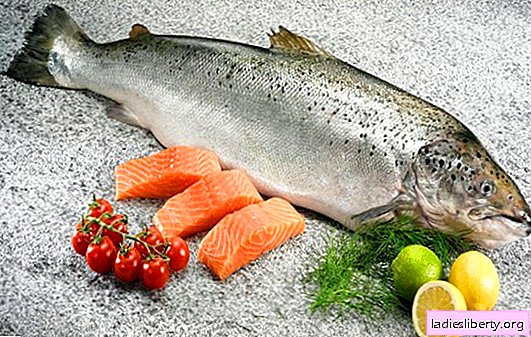
Salmon is not only a delicious fillet, but also red caviar, milk and fish oil. Salmon belongs to one of the most useful and suitable gifts for the water world and there are almost no contraindications to its use.
How salmon benefits are explained despite the fact that there is no such fish in the world
Salmon is the collective name of many fish, combined by a number of characteristics.
Their complex classification goes back to the order of salmonids with a single salmon family, which further breaks up into subfamilies - grayling (1 genus), whitefish (3 genera) and salmon (7 genera).
This common name includes chum salmon, coho salmon, whitefish, omul, salmon, grayling, pink salmon, lenok, sockeye salmon, trout, chinook salmon, taimen and other fish.
Salmon - freshwater or migratory inhabitants of the northern hemisphere, predators or adhere to a mixed diet, they are very different in appearance and habits.
Often, what kind of fish can be called salmon, there is confusion. But very often salmon means salmon. And every salmon certainly has pink-red meat.
And nelmu with whitefish, for example, because of the light color, the fillets are called white fish.
Bright salmon meat is a well-known delicacy, there are few bones in it, it does not lose weight and size when cooked and is suitable for both the simplest recipes (steamed or grilled steak) and gourmet dishes.
Cream soup and ear, salads, pasta and omelettes, stuffing in pancakes and pies, stews and meatballs. It is also served as salted and in the form of sushi. Salmon is strongly combined with any products (and amazingly well with citrus fruits), seasonings and wines.
Refined salmon is liked even by those who, in principle, do not like fish.
But salmon meat is also distinguished by excellent nutritional and beneficial qualities.
True, in order to feel this in full, he should appear 3-4 times a week on the table.
Moreover, although you can say something different about each type of fish, all salmon (and take salmon as an example) share common characteristics in this regard.
The energy value of salmon fillet more than other indicators depends on the specific type of fish and, of course, the method of cooking.
But on average, this characteristic rotates about 140-170 kcal per 100 g of boiled fish and 180-260 for fried or baked.
Of particular importance in the composition of salmon is the omega-3 fatty acid, which is simply not synthesized by the human body and must be ingested with food.
And just 100 grams of salmon more than half the daily requirement for omega-3s.
Combining all its properties, we can say that it contributes to:
· The disappearance of inflammatory processes in the body;
· Regeneration of damaged tissues, including mucous membranes;
· Improving brain activity and Alzheimer's prevention;
Hematopoiesis;
· The reproduction and preservation of a population of beneficial bacteria in the intestine;
· Healthy eyesight, since it protects the eyes from dryness, the appearance of yellow spots, astigmatism and chronic fatigue;
· Retreat of aging processes due to slowing down of shortening of the end sections of chromosomes;
· Prolongation of youth by stimulating the production of collagen necessary in the fight against wrinkles.
Due to the reaction of Omega-3 and vitamin D, the production of insulin is activated, which optimizes digestibility, the absorption of sugars by the body, resulting in a decrease in blood glucose.
The same reaction of two important elements of salmon composition has the effect of an antidepressant.
It is also important to note that rarely what kind of product in an amount of only 100 g is able to cover the daily need for vitamin D.
In salmon meat, B vitamins are fully represented, which are most effective just in the selection, mutually enhancing their effect on the body.
These vitamins are actively involved in the processes of cell formation and hormone production, they are necessary for the health of the nervous system, so we can directly say that salmon is indicated for depressive conditions, increased irritability and chronic fatigue.
Salmon contains calcium (its percentage is especially high in canned fish), potassium, sodium, magnesium and phosphorus. Selenium, which is part of vitamin-mineral complexes, is obtained, as a rule, from salmon.
Salmon is an easily digestible protein and the so-called good fats, so it is recommended to include it in the diet during the recovery period after serious illnesses.
When will salmon benefit?
Long-term studies have confirmed that people who like to eat salmon are less susceptible to infectious diseases, they fractures grow together faster, they have strong immunity and almost no cardiovascular diseases.
For those who follow the figure, salmon will be useful because it improves metabolism and speeds up metabolism, promotes the removal of toxins and toxins, and during periods of intense training (but this can be said of any increased physical exertion) it improves the adaptation of muscles and ligaments.
The importance of salmon for health is difficult to overestimate; its benefits are multifaceted:
· Salmon heals the liver and optimizes its work as the main cleansing "station" of the body;
· Relieves symptoms of sinusitis and rhinitis;
· Prevents complications after acute respiratory viral infections and acute respiratory infections;
· For the formation of strong teeth, almost not susceptible to the harmful effects of sweets and common diseases (caries, periodontitis, periodontosis), it is very desirable to introduce salmon into the weekly diet from childhood, adolescence. But for adults it is very useful in this regard. For example, it can slightly reduce the sensitivity of tooth enamel.
How caviar is the most delicious salmon
Salmon spawning is one of the most beautiful, spectacular spectacles in wildlife, when fish with a changed bright color go along rivers, often stormy, overcoming rapids.
At this time, salmon meat is not of great value, and they get it mainly for caviar.
Its value is generally comparable to the salmon, but in a more concentrated form. In addition, it has a much higher concentration of amino acids.
The most valuable is caviar from chum salmon, sockeye salmon, pink salmon, chinook salmon and coho salmon.
It is worth noting the benefits of caviar in relation to the blood and circulatory system, for which it:
· Increases hemoglobin;
· Reduces cholesterol and prevents scarring of the walls of arteries and veins;
· Minimizes the risk of blood clots;
· Stimulates the formation of blood cells;
· Saturates blood with oxygen;
· Improves its circulation in vital organs.
Even regular use of red caviar improves complexion and the condition of hair and nails.
What else is the use of salmon - milk and fish oil
Fish oil is mainly obtained from cod fish and sharks, and from salmon it is the least, but this does not reduce the value of salmon oil.
Saturated with fatty acids and vitamins, it is hotly demanded by the cosmetic, pharmacological and food industries.
But, if the salmon fillet is to your taste, it is not necessary to purchase pure fat.
The main thing is to choose chilled or frozen fish once and cook to taste, then the fat will give it juiciness and have a beneficial effect on the activity of the thyroid gland and the cardiovascular system, in particular by lowering the level of triglycerides in the blood (prevention of blood clots).
Milks are the seminal glands of male salmon, characterized by a specific taste. Usually they are fried quickly, served in batter and with sauce, in salad, fish paste, patty filling or ear.
For 100 g of product, they contain more than 10% polyunsaturated fatty acids, many vitamins PP and E, and in general they are no less useful than fish oil.
Take at least protamines - these low molecular weight proteins are able to enhance the effects of medications taken by humans. Also, milk can:
· To establish the digestibility of calcium, due to the vitamin B contained in them;
· Reduce swelling due to a violation of the water-salt balance;
· Increase physical endurance.
Can there be harm from salmon on a daily table
Salmon harvested in the wild are traditionally considered more environmentally friendly compared to farmers, but if you analyze its composition in detail, the difference between the two fish samples will be small. Provided that the producer does not abuse the addition of growth stimulants, antibiotics and dyes (for a more attractive type of pink meat) to the diet of salmon grown. If it feeds with these substances, there will likely be harm rather than benefit from such salmon.
It is noteworthy that salmon almost do not accumulate mercury and do not contain carcinogens.
Many scientists have confirmed that GMOs do not harm salmon. The fish is still healthy and its livestock has been inhabited by a number of western farming fish farms.
Pregnancy and breastfeeding of the baby, the postoperative period, problems with the gastrointestinal tract or pancreas - all this, in fact, is not an obstacle to eating salmon.
But it is worth remembering the likely harm of salmon due to its high calorie content, which can lead to weight gain and obesity.











